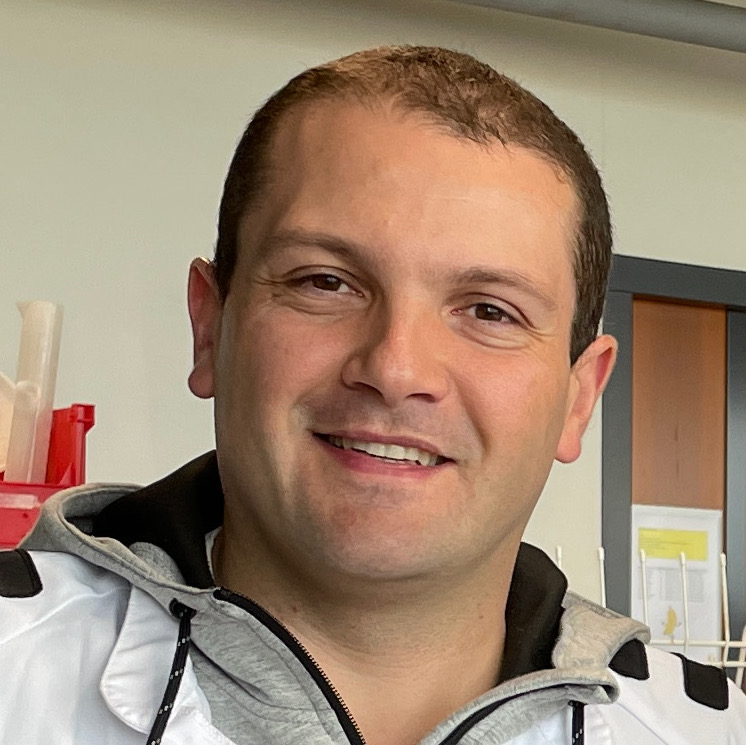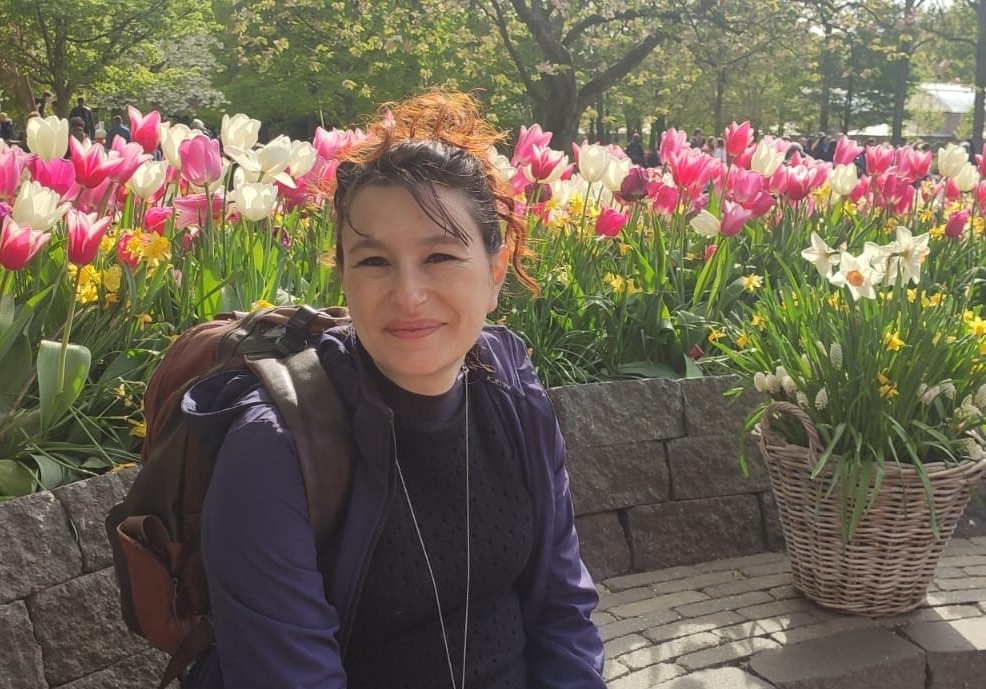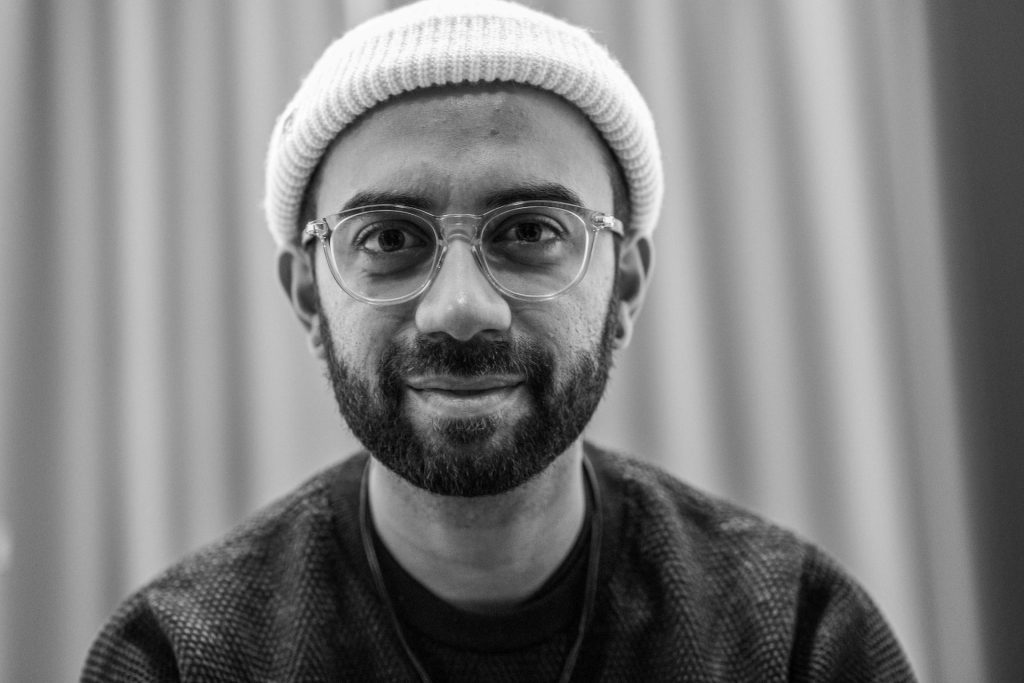Affiliated researchers

Dr. Edouard Evangelisti studies filamentous microorganisms and their interactions with plants, with a special focus on oomycetes. His research explores the molecular and cellular mechanisms of plant infection by oomycetes.
Show More
Key publications:
1. ‘Deep-learning based quantification of arbuscular mycorrhizal fungi in plant roots’, E. Evangelisti, C. Turner, A. McDowell, L. Shenhav, T. Yunusov, A. Gavrin, E. K. Servante, C. Quan, S. Schornack, New Phytologist 232(5), p. 2207-2219 (2021). https://doi.org/10.1111/nph.17697
2. ‘N-acetyltransferase AAC(3)-I confers gentamicin resistance to Phytophthora palmivora and Phytophthora infestans’, E. Evangelisti, T. Yunusov, L. Shenhav, S. Schornack, BMC Microbiology 19, p. 265 (2019). https://doi.org/10.1186/s12866-019-1642-0
3. ‘Hydrodynamic shape changes underpin nuclear rerouting in branched hyphae of an oomycete pathogen’, E. Evangelisti, L. Shenhav, T. Yunusov, M. Le Naour-Vernet, P. Rink, S. Schornack, mBio 10(5), p. 1-16 (2019). https://doi.org/10.1128/mBio.01516-19
4. ‘Time-resolved dual transcriptomics reveal early induced Nicotiana benthamiana root genes and conserved infection-promoting Phytophthora palmivora effectors’, E. Evangelisti, A. Gogleva, T. Hainaux, M. Doumane, F. Tulin, C. Quan, T. Yunusov, K. Floch, S. Schornack, BMC Biology 15, p. 39 (2017). https://doi.org/10.1186/s12915-017-0379-1.
5.‘The Phytophthora parasitica RXLR effector Penetration-Specific Effector 1 favours Arabidopsis thaliana infection by interfering with auxin physiology’, E. Evangelisti, B. Govetto, N. Minet-Kebdani, M.-L. Kuhn, A. Attard, M. Ponchet, F. Panabières, M. Gourgues, New Phytologist 199(2), p. 476-489 (2013). https://doi.org/10.1111/nph.12270
Show Less

Norbert Peeters (MA) is a lecturer in philosophy at Wageningen University and Research and an external PhD student at Leiden University. Norbert is currently in the process of finishing his PhD research into the historical and conceptual origins of plant invasion ecology. His other research is focused on the history and philosophy of botany, with a special interest in valorization and public understanding of plant sciences.
Show More
Key publications:
1. ‘Flora Batava 1800-1934 – De wilde planten van Nederland’, N.G.J. Peeters, E. van Gelder (eds.), Tielt: Uitgeverij Lannoo (2023).
2. ‘Rumphius’ Kruidboek – Verhalen uit de Ambonese flora’, N.G.J. Peeters, Zeist: KNNV Uitgeverij (2020).
3. ‘Botanische revolutie – De plantenleer van Charles Darwin’, N.G.J. Peeters, Zeist: KNNV Uitgeverij (2016).
Show Less

My expertise and research interest lie in molecular plant immunology. We study how the plant immune system is activated and how it influences plant growth and development. Several plant species, including lettuce, are used in the research. Through collaborations with industry in LettuceKnow and CropXR programs, we aim to translate our knowledge into breeding solutions for improved disease resistance.
Show More
Key publications:
1. Arabidopsis Topless-related 1 mitigates physiological damage and growth penalties of induced immunity. Thomas Griebel*, Dmitry Lapin* et al.; New Phytol. 239(4):1404-1419. (2023).
2.Variation in plant Toll/Interleukin-1 receptor domain protein dependence on ENHANCED DISEASE SUSCEPTIBILITY 1. Oliver Johanndrees, Erin L Baggs, … Dmitry Lapin; Plant Physiol. 191(1):626-642. (2023)
3. Direct pathogen-induced assembly of an NLR immune receptor complex to form a holoenzyme. Shoucai Ma*, Dmitry Lapin*, Li Liu*, Yue Sun*, Wen Song* et al.; Science, 370(6521):eabe3069. (2020)
4. A Coevolved EDS1-SAG101-NRG1 Module Mediates Cell Death Signaling by TIR-Domain Immune Receptors. Dmitry Lapin*, Viera Kovacova*, Xinhua Sun* et al.; Plant Cell, 31(10):2430-2455. (2019).
Show Less

Nora Gigli-Bisceglia is an assistant professor in the Plant Stress Resilience group at Utrecht University. Her lab focuses on understanding how plants sense and respond to cell wall modifications induced by abiotic stresses. Her research aims to unravel the molecular mechanisms behind these modifications, dissecting both the sensing mechanisms and the signaling pathways activated by cell wall alterations. By investigating these processes, her team seeks to expand our understanding of how plants can be made more resilient to extreme environmental conditions, which is crucial for adapting to a changing climate.
Show More
Key publications:
1. Arabinosylation of cell wall extensin is required for the directional response to salinity in roots. Zou, Y., Gigli-Bisceglia, N., van Zelm, E., Kokkinopoulou, P., Julkowska, M. M., Besten, M., Nguyen, T.-P., Li, H., Lamers, J., de Zeeuw, T., Dongus, J. A., Zeng, Y., Cheng, Y., Koevoets, I. T., Jørgensen, B., Giesbers, M., Vroom, J., Ketelaar, T., Petersen, B. L., …Testerink, C. The Plant Cell. Advance online publication. (2024). https://doi.org/10.1093/plcell/koae135
2. THESEUS1 modulates cell wall stiffness and abscisic acid production in Arabidopsis thaliana. Bacete, L., Schulz, J., Engelsdorf, T., Bartosova, Z., Vaahtera, L., Yan, G., Gerhold, J. M., Tichá, T., Øvstebø, C., Gigli-Bisceglia, N., Johannessen-Starheim, S., Margueritat, J., Kollist, H., Dehoux, T., McAdam, S. A. M., & Hamann, T. PNAS, (2022). 119(1). https://doi.org/10.1073/pnas.2119258119
3.Arabidopsis root responses to salinity depend on pectin modification and cell wall sensing. Gigli-Bisceglia, N., Zelm, E. V., Huo, W., Lamers, J., & Testerink, C. Development,149(12). (2022). https://doi.org/10.1242/dev.200363
Show Less

Pepijn Moerman is an assistant professor in the Self-Organizing Soft Matter Lab, interested in active soft matter and biomimetic systems. His group uses methods from DNA nanotechnology to develop experimental soft matter systems that mimic cell-cell communication, adhesion, and mechanics. They answer fundamental biological questions by systematically varying parameters in these cell mimics and quantifying their effects on the system’s self-organization. With this approach, the team aims to better understand the way cells interact to form tissues and to develop smart materials that can mimic life-like behaviors.
Show More
Key publications:
1. Directing Uphill Strand Displacement with an Engineered Superhelicase. Hall-Thomsen, H., Small, S., Gavrilov, M., Ha, T., Schulman, R., & Moerman, P. G. ACS Synthetic Biology, 12(11), 3424-3432. (2023).
2. A simple method to alter the binding specificity of DNA-coated colloids that crystallize. Moerman, P. G., Fang, H., Videbæk, T. E., Rogers, W. B., & Schulman, R. Soft matter, 19(45), 8779-8789. (2023).
3. Catalytic DNA polymerization can be expedited by active product release. Moerman, P. G., Gavrilov, M., Ha, T., & Schulman, R. Angewandte Chemie, 134(24), e202114581. (2022).
Show Less

Ruth Großeholz is an Assistant Professor at the Brightlands Future Farming Institute and the Maastricht Centre for Systems Biology at Maastricht University. Her research group uses computational modelling to analyse plant physiological and developmental process across multiple spatial and temporal scales.
Show More
Key publications:
1. Computational modeling of cambium activity provides a regulatory framework for simulating radial plant growth. Lebovka, I., Mele, BH., Liu, X., Zakieva, A., Schlamp, T., Gursanscky, NR., Merks, RMH., Großeholz, R., Greb, T. eLife 12:e66627. (2023)
2. Computational modeling and quantitative physiology reveal central parameters for brassinosteroid-regulated early cell physiological processes linked to elongation growth of the Arabidopsis root Großeholz, R., Wanke, F., Rohr, L., Glöckner, N., Rausch, L., Scholl, S., Scacchi, E., Spazierer, A-J., Shabala, L., Shabala, S., Schumacher, K., Kummer, U., Harter, K. eLife 11:e73031. (2022)
3. Specifying the role of BAK1‐interacting receptor‐like kinase 3 in brassinosteroid signaling. Großeholz, R., Feldman-Salit, A., Wanke, F., Schulze, S., Glöckner, N., Kemmerling, B., Harter, K., Kummer, U. Journal of Integrative Plant Biology. (2020) https://doi.org/10.1111/jipb.12803.
Show Less

Alexis Maizel’s research focuses on understanding the fundamental mechanisms of plant development, particularly root development in Arabidopsis thaliana. The main emphasis is on lateral root formation, a prime example of post-embryonic organogenesis that enhances plants’ ability to forage for nutrients and stabilize their anchoring. His work integrates studies of hormone signaling (especially auxin), mechanical forces, cellular dynamics, and gene regulation.
Show More
Key publications:
1. Auxin-mediated stress relaxation in pericycle and endoderm remodeling drives lateral root initiation. Ramos, J.R.D., Reyes-Hernández, B.J., Alim, K., and Maizel, A. Biophys. J. (2024) .https://doi.org/10.1016/j.bpj.2024.06.017.
2. Microtubule-based perception of mechanical conflicts controls plant organ morphogenesis.Stöckle, D., Reyes-Hernández, B.J., Barro, A.V., Nenadić, M., Winter, Z., Marc-Martin, S., Bald, L., Ursache, R., Fujita, S., Maizel, A., et al. Sci Adv _8_, eabm4974. (2022). https://doi.org/10.1126/sciadv.abm4974.
3. Integration of Cell Growth and Asymmetric Division during Lateral Root Initiation in Arabidopsis thaliana. Schütz, L.M., Louveaux, M., Vilches Barro, A., Bouziri, S., Cerrone, L., Wolny, A., Kreshuk, A., Hamprecht, F.A., and Maizel, A. Plant Cell Physiol. _62_, 1269–1279. (2021). https://doi.org/10.1093/pcp/pcab038.
4.Accurate and versatile 3D segmentation of plant tissues at cellular resolution. Wolny, A., Cerrone, L., Vijayan, A., Tofanelli, R., Barro, A.V., Louveaux, M., Wenzl, C., Strauss, S., Wilson-Sánchez, D., Lymbouridou, R., et al. Elife _9_, e57613. (2020). https://doi.org/10.7554/eLife.57613.
5.Cytoskeleton dynamics are necessary for early events of lateral root initiation in Arabidopsis. Vilches Barro, A., Stöckle, D., Thellmann, M., Ruiz-Duarte, P., Bald, L., Louveaux, M., von Born, P., Denninger, P., Goh, T., Fukaki, H., et al. Curr. Biol. _29_, 2443-2454.e5.(2019). https://doi.org/10.1016/j.cub.2019.06.039.
Show Less
Cell and Developmental biology – Centre for Organismal Studies (uni-heidelberg.de)

Erwin Peterman develops and applies single-molecule tools (fluorescence microscopy, optical tweezers, acoustic force microscopy) to unravel how life works on the molecular and cellular scale. These tools work on living multicellular organisms (C. elegans), cells, or isolated components (from intact chromosomes to purified proteins and DNA). Current topics involve intracellular transport in chemosensory cilia and neurons, chromosome mechanics, DNA repair and compaction, and cell mechanics and cell-cell interactions. He is cofounder of next-generation life science tool company LUMICKS b.v.
Show More
Key publications:
1. Ion-mediated condensation controls the mechanics of mitotic chromosomes. Witt, H., Harju, J., Chameau, E.M.J. et al. Nat. Mater. (2024). https://doi.org/10.1038/s41563-024-01975-0
2. Viscoelasticity of diverse biological samples quantified by Acoustic Force Microrheology (AFMR). Bergamaschi, G., Taris, KK.H., Biebricher, A.S. et al. Commun Biol 7, 683 (2024). https://doi.org/10.1038/s42003-024-06367-3
3. Introduction to Optical Tweezers: Background, System Designs, and Applications. Malinowska, A.M., van Mameren, J., Peterman, E.J.G., Wuite, G.J.L., Heller, I. In: Heller, I., Dulin, D., Peterman, E.J. (eds) Single Molecule Analysis . Methods in Molecular Biology, vol 2694. Humana, New York, NY. (2024). https://doi.org/10.1007/978-1-0716-3377-9_1
4. Bogatyr, V., Bebricher, AS., Bergamaschi, G., Peterman, EJG. and Wuite, GJL. ACS Nanoscience, 2 (4), 341-354. (2022). DOI: 10.1021/acsnanoscienceau.2c00002
Show Less

Udo Sen is an assistant professor in the Physical Chemistry and Soft Matter group, where he leads the Physics of Soft Matter (PhySM) team. With a training in experimental applied physics and applied mathematics, Udo, along with the PhySM team, tackles interdisciplinary questions in both living and non-living soft matter from the point-of-view of hydrodynamics and continuum mechanics. The PhySM team attempts to do so using table-top experiments, (ultra) high-speed microscopy, mathematical modeling, and numerical simulations. Some of the ongoing projects in the team are related to crystallization, dynamical assembly of colloidal materials, functional fluid interfaces, adhesion of insects, biophysics in developmental biology, and microbial response to climate change.
Show More
Key publications:
1. Evaporation of binary liquids in a capillary tube, L. Thayyil Raju, C. Diddens, J. Rodríguez-Rodríguez, M. N. van der Linden, X. Zhang, D. Lohse, and U. Sen, Journal of Fluid Mechanics, 983, A21 (2024).
2. Capillary adhesion of stick insects, G. J. Amador, B. K. van Oorschot, U. Sen, B. Karman, and R. Leenders, Annals of the New York Academy of Sciences, 1538, 98-106 (2024).
3. Taylor-Culick retractions and the influence of surroundings, V. Sanjay, U. Sen, P. Kant, and D. Lohse, Journal of Fluid Mechanics, 948, A14 (2022).
4. The retraction of slender jetted viscoelastic liquid filaments, U. Sen, C. Datt, T. Segers, H. Wijshoff, J. H. Snoeijer, M. Versluis, and D. Lohse, Journal of Fluid Mechanics, 929, A25 (2021).
Show Less
